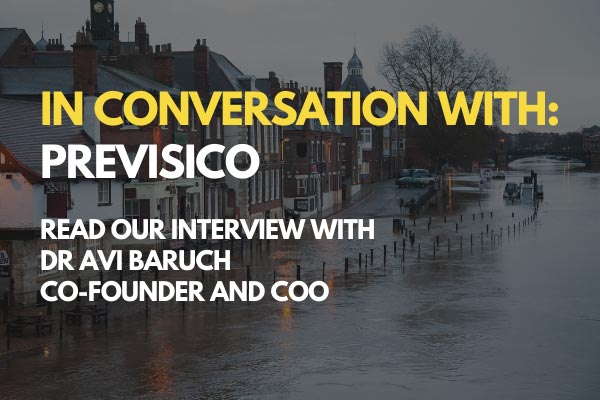In conversation with Previsico
Previsico provides flood alerts for specific property-level locations. Why do you focus on surface water flooding?
Despite surface water floods being the largest flood risk in the UK (Aviva estimates it affects one in five homes), they are not covered by existing warnings systems. The Environment Agency provides river and coastal flood warnings and surface water guidance statements, but there is no property-level flood warning service available from the UK government. The technology and analytics used by Previsico started as a research project at Loughborough University. This was in partnership with the Environment Agency and the Met Office to predict surface water flooding. Previsico can provide flood warnings up to two days in advance for individual property-level locations.
What is Previsico’s business model?
Our customers provide us with locations that they need flood alerts for. Customers subscribe per location per annum and we also charge for our dashboard and API. Previsico works directly with corporates. We also partner with insurers to provide our service to their policyholders.
How does Previsico work with insurers such as Zurich and Liberty Specialty Markets?
Previsico has been providing flood forecasts for BT, one of Zurich’s large corporate clients. This helps BT to protect its property and assets and to reduce callouts from false alarms. This allows the company to send resources to the right location at the right time. Liberty Specialty Markets provides Previsico’s service to all of its UK Commercial Customers through its Risk Reduce portal.
What can organisations do once they receive a flood warning?
Protecting property from flooding requires timely and accurate warnings that trigger a flood plan, which organisations with properties in flood-exposed locations should have in place to mitigate risk and reduce losses.
A flood action plan will include measures such as moving stock to higher ground, protecting staff and key equipment and shutting off electricity. Most insurers provide guidance on actions to take when policyholders are at risk of flood.
We are also now working with insurers and our flood resilience partner Watertight International, which designs, sources, installs and maintains property flood resilience solutions, such as flood barriers.
Read InsTech London’s article Building flood resilience in the UK to learn more about the actions that can be taken to mitigate flood damage.
Aside from floods, where are prediction and prevention strategies working effectively?
A good example is what is happening in the cyber space. Insurers like Liberty and Aviva have started to provide effective cyber risk advisory services to their customers. Aviva for example partnered with STORM to provide businesses with cyber risk strategies. It is important for insurers to engage with companies providing prediction and prevention services in a range of areas to improve their customer propositions.
Is IoT likely to be used more in the future for these strategies?
There is a move in the insurance industry to increase the uptake of IoT. Previsico is part of SENSE Consortium, a group of insurers and practitioners that aim to encourage the uptake of IoT for commercial risk reduction. There are so many connected devices that can help organisations reduce risk and improve energy efficiency. At Previsico we have our own sensors that we install on rivers, streams and culverts that are close to vulnerable properties and equipment. Our network of sensors means that we can forecast a flood in real-time and monitor it on the ground.
Every insurer is working on its ESG strategy. How does Previsico’s offering fit into this?
There is significant overlap between insurance and ESG (environmental, social and governance) issues, including for flood risk. For ‘E’ issues, many businesses face challenges if flooded as chemicals and waste can contaminate flood water. For the ‘S’ impact, around 40% of businesses never reopen after a flood. In terms of the ‘G’ impact, insurers and banks are required to undertake stress tests that assess their vulnerability to flooding, while boards and investors require that governance around climate change risk is taken seriously. Previsico’s live flood forecasts can support all areas of ESG.
How can flood resilience be improved?
Real-time monitoring systems should be in place, flood action plans should be improved and “build back better” should be encouraged when properties are flooded. Climate change is going to exacerbate flash flooding events, so building up flood resilience is an important part of ESG strategies.
What do you mean by “build back better”?
When properties or infrastructure are damaged by a flood, the repairs should make the structure more resilient to future flooding. Homeowners in the UK are now able to receive a grant after they have been affected by flooding, allowing measures to be put in place that improve the property’s resilience. There is also going to be an announcement in Parliament on the 22nd April about it. At the moment, insurers such as Aviva and NFU are leading the way in “build back better”. In the UK and Canada, Aviva offers coverage to install devices to reduce future risk after a claim.
What should readers do if they want to learn more about Previsico?
At Previsico we are keen to partner with insurers, corporates and larger businesses, and partners operating in the flood space as part of our wider ecosystem, worldwide.
Anyone wanting to know more about our proposition can reach out to me on LinkedIn.


